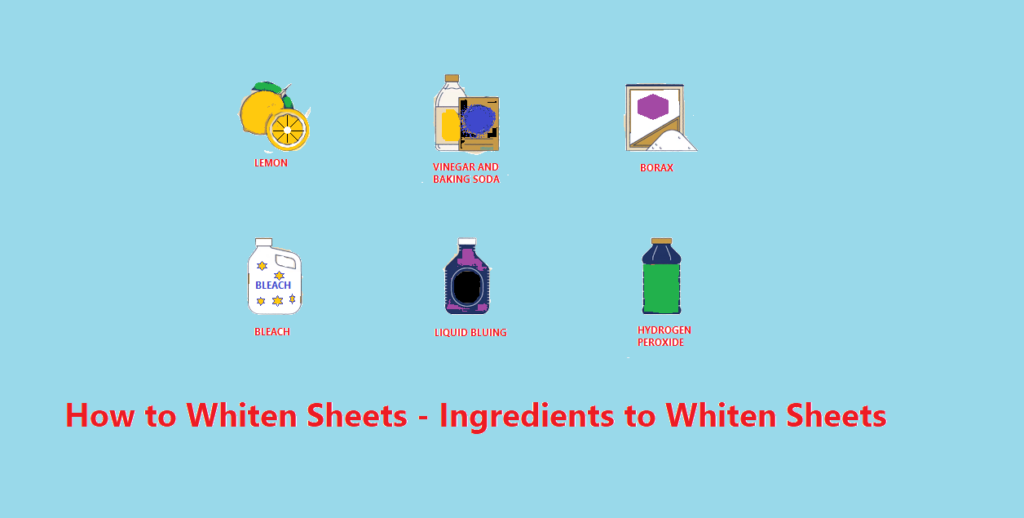How to Whiten Sheets that have turned yellow? Clean, white bed sheets are a dream for every sleeper. The pristine appearance of white sheets not only adds a touch of elegance to the bedroom but also creates a sense of calm and relaxation. However, maintaining the whiteness of bed sheets can be a challenging task. Over time, light-colored sheets tend to develop a yellowish tinge, making them look worn out and unappealing.
Today we will provide effective tips and techniques to bring back the sparkle to your bedding, eliminating the need for frequent replacements.
Keep reading the article to learn how to whiten sheets and prevent them from getting yellowing.
How to Whiten Sheets
How to Whiten Sheets Without Bleach
In this section, we will explore various methods and household items that can help make your sheets white again. These methods include:

Using Borax
Borax is a white mineral and a laundry booster that can be easily found in grocery stores. Pre-soaking your sheets in a solution of borax and water can help remove the yellow tinge. Subsequently, washing the sheets with a mild detergent completes the process.
Pre-Soaking with Vinegar
Vinegar is a versatile household product that can be used to pre-soak sheets before washing. Mixing vinegar with warm water and soaking the sheets for an hour helps remove stains and odor. Air-drying the sheets afterward eliminates any lingering vinegar smell.
Boosting with Baking Soda
Baking soda acts as an odor neutralizer and a natural whitening agent. Adding baking soda to your regular laundry detergent enhances its cleaning power, resulting in clean, odor-free white sheets.
Lemon Juice to Whiten sheets
The citric acid present in lemons serves as a natural bleaching agent. Mixing lemon juice with your regular detergent or soaking sheets in lemon juice and water can help whiten them. This method is not recommended for silk sheets.
Using Hydrogen Peroxide
Hydrogen peroxide acts as a mild bleaching agent and disinfectant. Adding it to your washing machine along with detergent can effectively whiten yellowed sheets.
Liquid Bluing Helps Whiten Sheets
Liquid bluing counteracts the yellow shade, making sheets bright white again. Diluting liquid bluing in cold water and adding it to the wash cycle can help restore the whiteness of sheets.
Line Drying in the Sun
Sunlight has natural bleaching properties, and hanging your sheets outdoors can enhance their brightness. However, it is essential to monitor the weather and avoid excessive exposure to heat that may damage the fabric.
Key Takeaways: Learn how to whiten sheets without bleach using various household items and methods. Borax, a laundry booster, can remove yellow tinges by pre-soaking sheets in a borax and water solution. Mixed with warm water, vinegar eliminates stains and odor when sheets are soaked for an hour. Baking soda added to laundry detergent acts as an odor neutralizer and natural whitening agent. Lemon juice, hydrogen peroxide, and liquid bluing also contribute to whitening. Finally, line-drying sheets in sunlight enhances their brightness.
Best Practices for Maintaining White Sheets
Apart from whitening techniques, maintaining the whiteness of bed sheets requires proper care and washing practices.
Now we will learn some useful tips for washing and drying white sheets to ensure they stay fresh and bright for an extended period. It covers topics such as:
Selecting the Right Products:
Choosing laundry boosters like OxiClean, borax, or baking soda can help maintain the whiteness of sheets without damaging the fabric.
Washing Frequency:
While it is essential to clean sheets regularly, overwashing can lead to premature wear and tear. Striking a balance between cleanliness and fabric preservation is Pulling your sheets out of the dryer while they are still slightly damp can also prevent wrinkles.
Smooth them out and lay them flat to finish air-drying. If you prefer the crispness of line-dried sheets, hang them outside on a clothesline. The sunlight will also help naturally bleach and brighten the fabric.
Summary: Proper care and washing practices are crucial to maintaining the whiteness of bed sheets. Choose laundry boosters like OxiClean, borax, or baking soda to preserve the fabric’s whiteness. Find a balance between washing frequency and fabric preservation. Remove sheets from the dryer while slightly damp to prevent wrinkles. Lay them flat or hang them outside on a clothesline for a crisp, line-dried feel. Sunlight naturally bleaches and brightens the fabric.
Understanding Yellowed Sheets
White sheets turning yellow is a common occurrence due to the accumulation of sweat, body oils, and skincare products on the fabric fibers.
These substances cling to the sheets, causing a yellowish discoloration that regular laundry detergent may not effectively remove.
Despite efforts to minimize yellowing, it is nearly impossible to prevent it entirely. However, by following the tips outlined in this article, you can restore the whiteness of your sheets and extend their lifespan.
How to Whiten Yellowed Sheets

There’s something incredibly satisfying about sinking into a clean, fresh bed at the end of a long and tiring day. The experience is even more delightful when your bed is adorned with clean, white sheets.
Interestingly, research suggests that white or light-colored bed sheets have a calming effect on our nervous system. Their minimal visual stimulation allows our brains to process less information, resulting in a more relaxed state.
Over time, however, those once immaculate white sheets can start to lose their luster and develop an unsightly yellow tint. This yellowing is a common occurrence that happens due to regular use and the accumulation of sweat, body oils, and dead skin cells.
If you’re looking to restore the brightness of your yellowed sheets, you can employ several tried-and-tested methods.
- While bleach may seem straightforward, it’s not the best choice in the long run. Bleach contains chlorine, which reacts chemically with protein stains and leads to yellowing.
- Additionally, it can strip the softness from your cotton sheets. Instead, consider using eco-friendly household cleaners that are safe for regular use.
- One effective ingredient for whitening sheets is baking soda. It works wonders in neutralizing stains and discoloration.
- Another great option is white vinegar, which can be used for a wonderful pre-soak either on its own or in combination with another sheet-whitening agent.
- If you prefer a refreshing citrus scent, lemon juice is a fantastic choice. Its acidic properties may also help combat mites and bacteria, although this claim has limited scientific evidence.
- Liquid bluing is another method that can counteract yellow hues and create a crisp white appearance. Just like adding a blue layer to make photos look whiter, liquid bluing works in a similar fashion.
However, it’s crucial to carefully follow the instructions and dilute it adequately, as it can stain the sheets if used incorrectly.
Correct Process to Wash and Whiten Sheets
Now that we have a range of whitening options at our disposal, it’s important to approach the process patiently and methodically.
- To begin, consider pre-soaking the sheets in warm water with half a cup of white vinegar.
- Alternatively, you can opt for an overnight pre-soak in cold water with the same amount of white vinegar. For either method, you may choose to use a laundry booster alongside the vinegar.
- Add half a cup of baking soda and your regular detergent during the first wash cycle. Then, when the rinse cycle begins, introduce half a cup of white vinegar or lemon juice.
These natural whiteners not only restore brightness but also have a softening effect, so you can skip using fabric softeners.
- If you detect any lingering odors or residues from the detergent, baking soda, or vinegar, it’s wise to proceed with a second cycle. This cycle should focus solely on rinsing without the need for additional detergent. By doing so, you can ensure your sheets are thoroughly cleaned and free of any unwanted scents.
- If weather permits, take advantage of the natural bleaching power of sunlight. Hang your washed sheets outside to dry; sunlight can help remove stains without setting them like a dryer might.
It’s a cost-effective and eco-friendly method to enhance the whiteness of your sheets.
In addition to the whitening process, there are a few additional tips to keep in mind.
- Washing white sheets separately from darker or vibrant-coloured items is best to prevent colour transfer.
- Regularly washing your white sheets, ideally once a week or every 4-5 days if you tend to sweat a lot, will help maintain their brightness.
- If you’re prone to sweating during sleep, consider finding ways to stay cool, as excessive sweat can contribute to yellowing.
Summary: To whiten sheets, bleach may not be ideal, as it can lead to yellowing and affect softness. Instead, try baking soda, white vinegar, or lemon juice for whitening. Liquid bluing can counteract yellow hues. Pre-soak with vinegar, use baking soda and natural whiteners in the wash and rinse thoroughly. Sun-drying can remove stains. Wash white sheets separately, wash regularly, and manage sweat to maintain the whiteness.
Tips to Prevent Yellowing and Maintain White Sheets
Now that you know how to whiten your sheets, it’s important to adopt some preventive measures to keep them white for longer. Here are some tips to help you maintain the brightness of your white sheets:
- Shower before bed: By showering before you sleep, you can remove excess body oils, sweat, and lotions that can cause yellowing.
- Use a mattress protector: Investing in a mattress protector can help prevent the transfer of body oils and sweat onto your sheets. It acts as a barrier between your body and the mattress, keeping your sheets cleaner for longer.
- Wash your sheets regularly: Regular washing of your sheets is essential to remove accumulated dirt, oils, and sweat. Aim to wash your sheets at least once every one to two weeks, depending on your personal preferences and needs.
- Separate white and colored laundry: To prevent color transfer and potential staining, always wash your white sheets separately from colored items.
- Follow care instructions: Pay attention to the care instructions on the label of your sheets. Different fabrics may have specific washing instructions to maintain their quality and whiteness.
- Avoid using excessive heat: High heat can damage the fibers of your sheets and cause them to yellow. Opt for lower temperature settings when washing and drying your sheets.
- Treat stains promptly: If you notice any stains on your sheets, treat them as soon as possible. Follow the appropriate stain removal methods for the specific type of stain to prevent it from setting in and causing yellowing.
- Store sheets properly: When not in use, store your white sheets in a clean, dry, and well-ventilated area. Avoid storing them in plastic bags or containers, as this can trap moisture and promote yellowing.
- Rotate your sheet sets: Having multiple sets of sheets and rotating them can help prolong their lifespan. By alternating between sets, you give each set time to rest and recover from wear and tear.
- Consider professional cleaning: Professional cleaning services may be beneficial for stubborn stains or heavily soiled sheets. They have specialized techniques and products to remove stains and restore the whiteness of your sheets effectively.
Summary: To maintain the whiteness of your sheets, shower before bed, use a mattress protector, wash regularly, separate white and colored laundry, follow care instructions, avoid excessive heat, treat stains promptly, store properly, rotate sheet sets, and consider professional cleaning if needed.
Enjoy Crisp and Bright White Sheets
Clean, white sheets enhance the visual appeal of your bedroom and provide a fresh and comfortable sleeping experience.
With the techniques and tips to whiten sheets mentioned in this article, you can bring back the brilliance to your yellowed sheets and keep them looking their best for a long time.
Remember to choose the method that is suitable for your specific fabric and always follow the care instructions provided.
By adopting proper care and maintenance practices, you can enjoy the luxury of crisp, bright white sheets every night, creating a serene and inviting sleep sanctuary.
After you’ve successfully whitened and maintained your sheets, there are a few additional tips to help keep them in top condition:
- Avoid harsh chemicals: When washing your sheets, steer clear of bleach or harsh laundry detergents. These can damage the fabric fibers over time and lead to yellowing. Instead, opt for milder, fabric-friendly detergents.
- Opt for natural remedies: If you prefer using natural methods, you can try a few remedies to help whiten your sheets. For example, adding half a cup of lemon juice or white vinegar to the wash cycle can act as a natural brightening agent.
- Test new products: Before using any new laundry product on your white sheets, it’s advisable to test it on a small, inconspicuous area first. This way, you can ensure it doesn’t cause any adverse effects or discoloration.
- Iron carefully: Ironing your sheets can give them a polished and crisp look. However, make sure to follow the ironing instructions for your specific fabric type and use the appropriate heat settings to avoid damaging the fibers.
- Avoid direct contact with body products: While using body lotions, oils, or creams, try to minimize direct contact with your sheets. These products can leave residue on the fabric and contribute to yellowing over time.
- Be cautious with makeup: If you apply makeup while sitting or lying on your bed, take care to prevent makeup stains from transferring onto your sheets. Consider using a towel or cloth to protect your bedding during your beauty routine.
By following these additional tips, you can further extend the lifespan and brightness of your white sheets. Regular maintenance and proper care will ensure that you continue to enjoy the fresh and inviting look of your bedding.
Summary: To maintain the brilliance of your white sheets, avoid harsh chemicals, try natural remedies, test new products, iron carefully, avoid direct contact with body products and be cautious with makeup. Regular maintenance and proper care will extend the lifespan and brightness of your bedding.
Conclusion
In conclusion, maintaining the brightness and whiteness of bed sheets is achievable with the right techniques and care. Yellowing of sheets is a common issue caused by sweat, body oils, and other factors, but it can be remedied.
By utilizing methods such as pre-soaking with vinegar or lemon juice, adding baking soda or borax to the wash, incorporating liquid bluing, or using hydrogen peroxide, you can effectively whiten your sheets without the need for harsh bleaching agents like chlorine bleach.
In addition to whitening techniques, it’s important to follow best practices for maintaining white sheets. This includes washing them regularly, using appropriate laundry products, separating white sheets from colored laundry, and air-drying in the sun when possible.
Preventive measures such as showering before bed, using mattress protectors, and treating stains promptly can also help prolong the whiteness of your sheets.
You can enjoy the luxurious and inviting experience of slipping into clean, white sheets every night with proper care and attention. So, embrace these tips, implement them in your laundry routine, and revel in the crispness and brightness of your bed linens.
ALSO READ:
Woman’s Dress changes color from white to Pink in the Sun – Watch Video




